President’s Message: Moving the Needle to Improve Daily Practice Through Organized Medicine
Cite as: Provenzano D. President’s message: moving the needle to improve daily practice through organized medicine. ASRA Pain Medicine News 2023;48. https://doi.org/10.52211/asra080123.001.
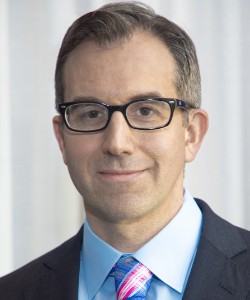 Congratulations to Samer Narouze, MD, PhD and Stephen Haskins, MD, #ASRASPRING23 Program Chair; the faculty, and the ASRA Pain Medicine staff on a great 48th Annual Regional Anesthesiology and Acute Pain Medicine Meeting
in Hollywood, Florida. The content was excellent, and it was a joy to spend time with the membership. When I spoke to people at the meeting, there were many common themes, such as excitement about the specialty and the new science around pain and
the advancement of treatment options. Once you moved beyond the meeting, another common theme, unfortunately, was that individuals are challenged with daily obstacles secondary to treating patients, including increasing work demand, declining reimbursement,
reduction in nonclinical time, administrative burden, prior authorizations, “scope creep,” medical corporate capitalization, and loss of control (Figure 1).
Congratulations to Samer Narouze, MD, PhD and Stephen Haskins, MD, #ASRASPRING23 Program Chair; the faculty, and the ASRA Pain Medicine staff on a great 48th Annual Regional Anesthesiology and Acute Pain Medicine Meeting
in Hollywood, Florida. The content was excellent, and it was a joy to spend time with the membership. When I spoke to people at the meeting, there were many common themes, such as excitement about the specialty and the new science around pain and
the advancement of treatment options. Once you moved beyond the meeting, another common theme, unfortunately, was that individuals are challenged with daily obstacles secondary to treating patients, including increasing work demand, declining reimbursement,
reduction in nonclinical time, administrative burden, prior authorizations, “scope creep,” medical corporate capitalization, and loss of control (Figure 1).
Multiple studies have demonstrated that there is a rising prevalence of burnout among clinicians, which is greater than 50% in some studies. Surveys dedicated to our specialty have demonstrated burnout rates of 63% for chronic pain physicians and 45% for acute pain specialists as specified by Maslach Burnout Inventory-Human Services Survey.1Government organizations, such as the Agency for Healthcare Research and Quality, have made this a research priority to find solutions. In addition, news publications, such as the Wall Street Journal, have recently published articles highlighting physician challenges, including moral injury.2 As one article describes, physicians are caught between their Hippocratic Oath and the demands of corporate healthcare.2 Furthermore, a second article discusses how resident physicians at the Mass General Brigham are attempting to unionize.3
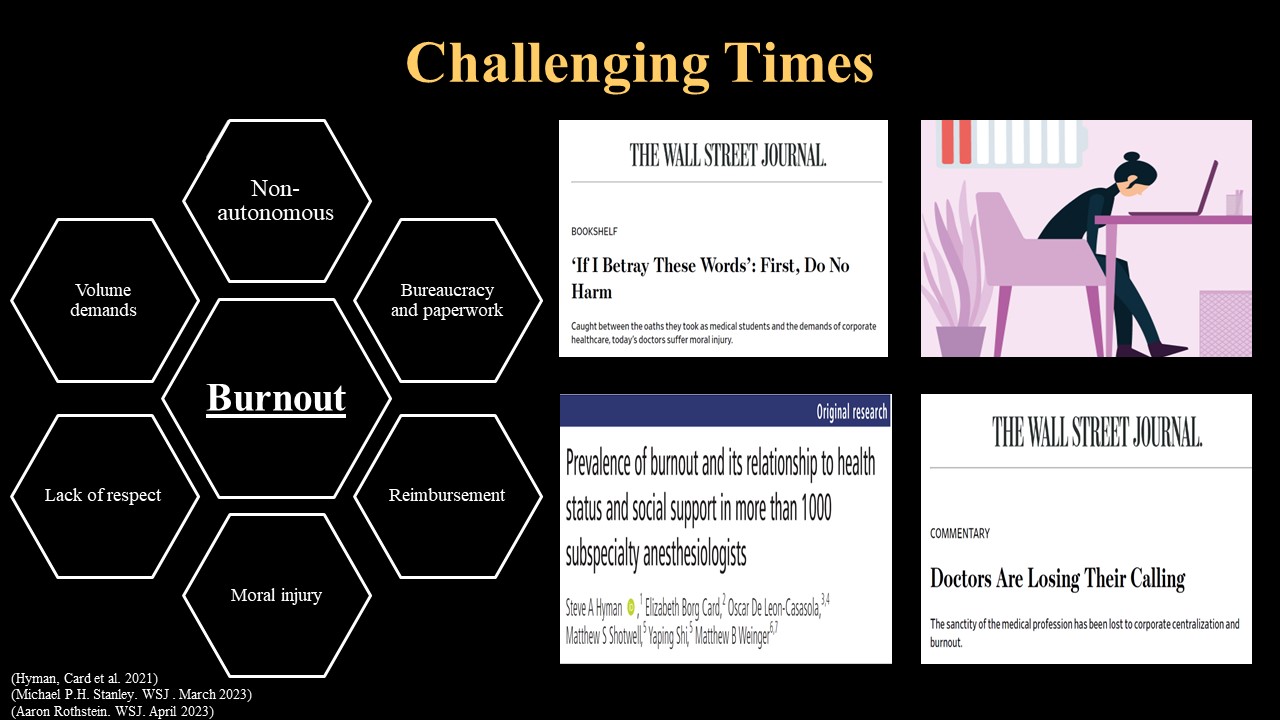
Figure 1
Although multiple strategies have been pushed by healthcare systems to deal with burnout, for instance yoga and meditation retreats, and counseling, these solutions are inadequate. Many of the solutions proposed lead to increased victim mentality, which does not improve the situation. As physicians, we all know that exercise, nutrition, social connection, and sleep are critical to health and well-being, but these are not the fundamental factors driving physician burnout, depression, and disenchantment. None of these strategies will fix long hours, decreasing satisfaction, declining reimbursement, staffing shortages, and increasing paper and digital work. Organizational solutions will be needed to create sustainable effective improvements in physician well-being. It is clear the healthcare system is broken, and until steps are taken to improve the healthcare system and regain physician autonomy and leadership, burnout will continue to increase.
During the last 10 years, I have become very involved in how physicians can take steps to improve healthcare. Initially, I became very interested in writing letters to government agencies and insurance companies on topics that are important to physicians, including reimbursement challenges. Although I would not discourage individuals from writing these letters, from the society’s standpoint, I did not see much change. It became clear to me that the only way we can make fundamental change is by bringing together a large group of physicians from multiple specialties through organized medicine. ASRA Pain Medicine can participate in organized medicine since it officially became seated in the American Medical Association (AMA) in June 2022. Now, ASRA Pain Medicine has two seats in the AMA House of Delegates (held by David Provenzano, MD, and Gary Schwartz, MD with Richard Chou, MD, serving as an alternate), two members serving as part of the Current Procedural Terminology Committee (Houman Danish, MD, and David Flynn, MD), and two members on the Relative Value Scale Update Committee (Trent Emerick, MD, and Matthew Thames, MD). We also have a Resident and Fellow Section representative, Lee Tian, MD. ASRA Pain Medicine also participates in the Pain and Palliative Medicine Specialty Section Council and the Mobility Caucus.
The only way we can make fundamental change is by bringing together a large group of physicians from multiple specialties through organized medicine.
Table 1. Organizations participating in the AMA Pain and Palliative Medicine Specialty Section Council and the Mobility Caucus
| Pain and Palliative Medicine Specialty Section Council | Mobility Caucus |
|
|
Founded in 1847, the AMA professional association and lobbying group of physicians and medical students had more than 270,000 members in 2022. Although the AMA has multiple priorities, four of its main priorities are critical to ASRA Pain Medicine members: reforming Medicare payment, fighting “scope creep,” fixing prior authorization, and reducing physician burnout. In June, Drs. Schwartz and Tian and I attended the AMA House of Delegates (HOD) meeting. While at the meeting, I also attended the Scope of Practice Summit. After I left that HOD meeting, it was clear to me that if we all work together and focus our energy, the medical system can be fixed. The AMA HOD, which includes nearly 700 physicians and medical students, represents every state medical association and more than 100 other national specialty organizations.
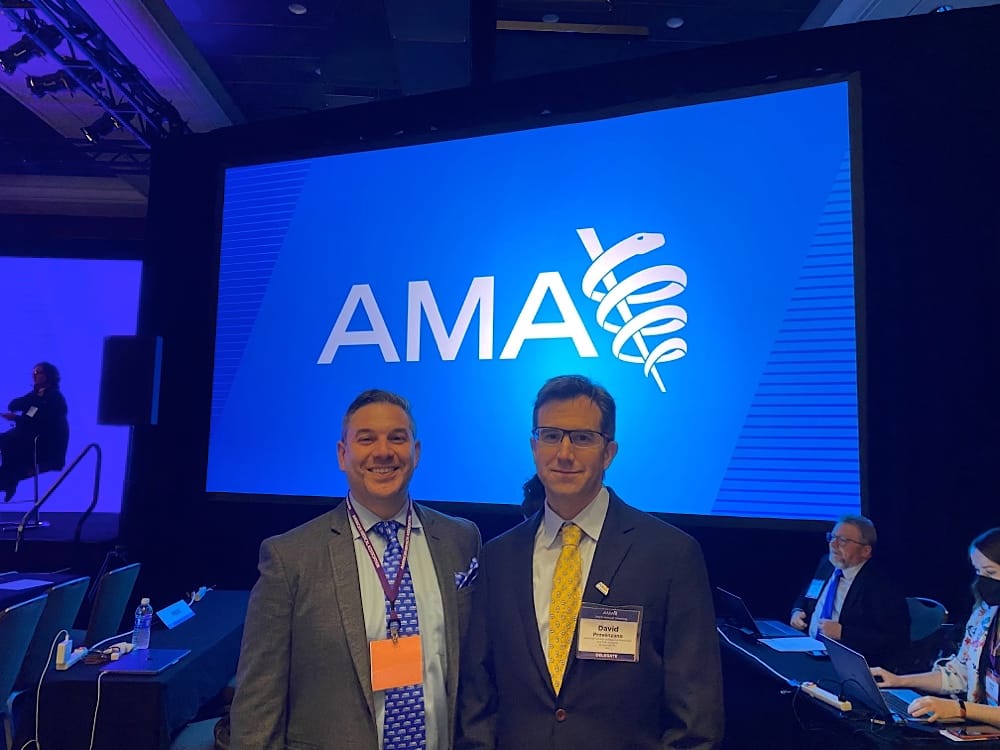
Drs. Provenzano and Schwartz
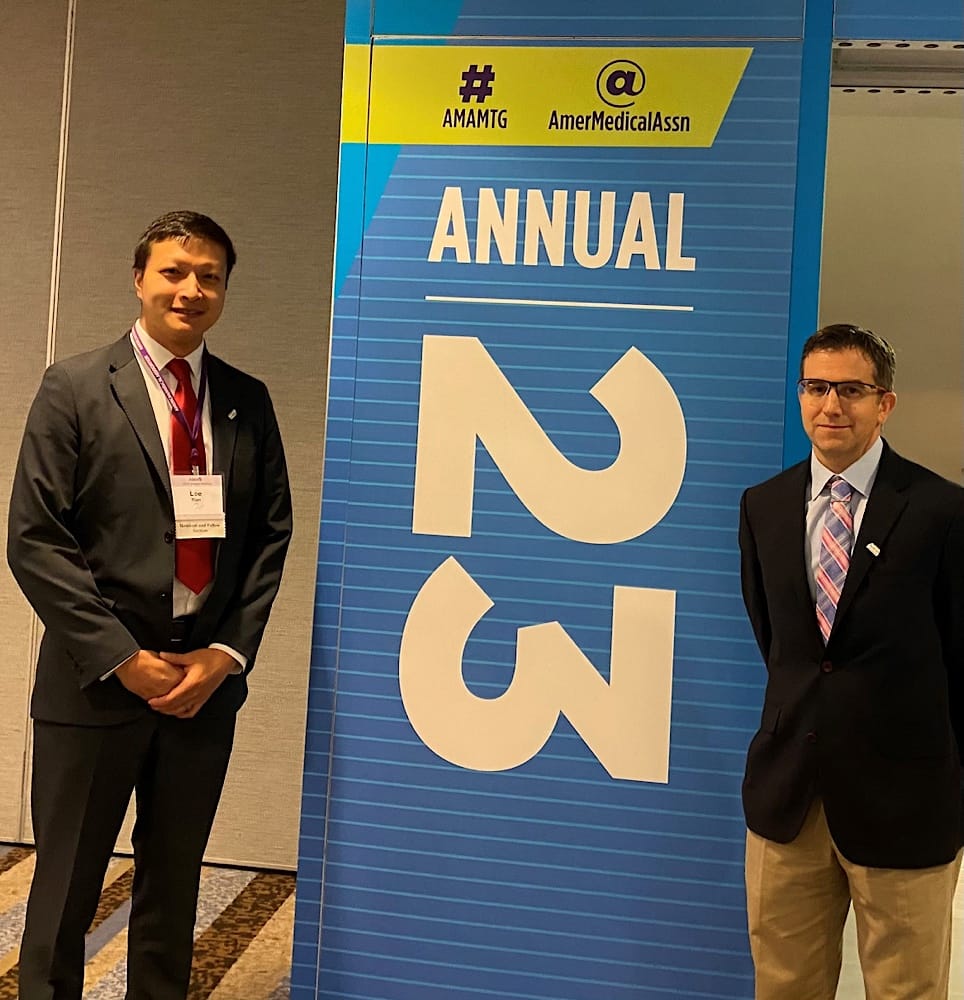
Drs. Provenzano and Tian
At the AMA HOD meeting, multiple items were covered that directly affected ASRA Pain Medicine members. (Full list of ASRA Pain Medicine Board supported recommendations or resolutions available in Appendix.) Resolutions were voted on and adopted that covered such topics as utilization review, prior authorization, bundled payments, multiple payments covered by modifier 25, promoting proper oversight and reimbursement for specialty non-physician practitioners, buprenorphine harm reduction, telemedicine, advocacy and action for a sustainable medical system, increased naloxone access in schools, repealing the ban on physician-owned hospitals, supporting fentanyl test strips, regulation of kratom, and opposing the scheduling of gabapentin.
One of the most significant resolutions that was adopted (Alternate Resolution 214 – Advocacy and Action for a Sustainable Medical Care System) involved moving forward policy that declared Medicare physician payment reform as an urgent AMA advocacy and legislative priority. This resolution prioritizes significant increases in funding for federal and state advocacy allocated to reforming Medicare physician payment and providing an update on progress in achieving Medicare payment reform. This is an essential need for physicians. While hospital and ambulatory surgical center reimbursement has increased, Medicare physician payment has effectively declined 26% from 2001 to 2023. The payments that we receive for providing physician-based services are no longer adequate and, in many cases, there are losses to a practice when providing services to Medicare beneficiaries. The AMA strategy to fix Medicare physician payments includes:
- Linking automatic inflation-based annual updates to the Medicare economic index.
- Updating budget neutrality requirements.
- Reforming the Medicare quality payment program by making the merit-based incentive payment system more clinically relevant and less burdensome.
- Making more alternative payment models available for practices to participate.
Recently, the power of organized medicine was seen when multiple organizations signed the AMA’s letter to Cigna urging the healthcare provider to rescind its policy on modifier 25.4 The AMA and more than 100 other physician and healthcare professional organizations raised significant concerns to Cigna regarding its new policy that office notes had to be submitted with all claims, including evaluation and management codes and modifier 25 when a minor procedure is billed. If this policy went into effect, it would have a significant negative impact on practice administrative costs and would negatively affect patient access to timely care. A patient deserves the right to receive a high-quality evaluation management visit where the physician can perform a minor procedure when needed.
For example, a physician completes a thorough evaluation of a patient, and one of the patient’s complaints is knee pain. The physician decides that the patient should have a corticosteroid intra-articular injection. The patient should have access to this care on the same day of service without significant administrative burden being placed on the practice. Based on the AMA letter, Cigna announced it was delaying implementation of its planned modifier 25 policy.
At the Scope of Practice Summit, the AMA discussed how the organization was going to protect access to physician-led care and demonstrate to government agencies that physician oversight is needed. “Scope creep” is a significant problem for multiple specialties, including anesthesiology and the practice of pain medicine. Anesthesiologists are used to dealing with “scope creep” with certified registered nurse anesthetists, but there are additional challenges with optometrists, physical therapists, pharmacists, chiropractors, physician assistants, and nurse practitioners. The AMA has multiple resources that are being deployed to ensure that physicians’ voices are heard.
For example, the AMA mapped the locations of primary care physicians and nurse practitioners nationwide in 2013, 2018, and 2020. This location mapping was performed to determine if allowing nonphysicians to practice without physician involvement increased access to care in rural and underserved areas. This is often an argument utilized for developing state law that allows nurse practitioners to practice without physician supervision or collaboration. The data collected in this AMA mapping location project clearly demonstrated that despite promises of nurse practitioners moving to rural and underserved areas after legislators removed physician supervision, this has not happened. Rather, physicians and nurse practitioners tend to practice in the same area of the state regardless of the scope of state practice laws. Although nonphysician providers are essential to providing high-quality medical care, physician oversight and leadership should be required. Physicians are trained to lead, and they have met extensive educational and training requirements, including residency and fellowships.
The AMA also recognizes the importance of preserving the independence and integrity of private practice; therefore, a Private Practice Physician Section (PPPS) is available. I encourage all private practice ASRA Pain Medicine physicians who are members of the AMA to join this section. The PPPS was instrumental at the HOD in passing resolution 727 requiring the AMA to assess and report on nationwide health system and hospital consolidation as well as payor consolidation to assist policymakers and the federal government in assessing the impact on delivering healthcare and maintaining physician practice. The collection of this data is critical.
Although vertical and horizontal organization has been suggested as one way to lower costs and improve healthcare, the promised improvements have not been realized. Vertical integration has often led to higher healthcare costs and larger delays in healthcare delivery.5 Furthermore, the employment of physicians has not been shown to improve hospital care, including quality measures.6 In addition, financial integration between healthcare providers and hospitals has been associated with higher commercial prices and spending for outpatient care.7
I would ask all private practice physicians to take advantage of all the offerings of the ASRA Pain Medicine Private Practice SIG founded and led by Drs. Maggie Holtz and Jennifer Noerenberg since 2021. The SIG has more than 400 members. Recently, Drs. Michael Hanes and Nicholas Bremer have been appointed to assist with adding additional resources for chronic pain specialists in this SIG. We will also continue to offer residents and fellows training (eg, webinars) on important topics of practice management from billing and reimbursement to building a practice.
Now that ASRA Pain Medicine can participate in the AMA, the society and its members can work with organized medicine to improve the healthcare system and subsequently improve physician well-being.
In conclusion, the delivery of healthcare and the future development of the healthcare system is critical to the members of ASRA Pain Medicine. Now that ASRA Pain Medicine can participate in the AMA, the society and its members can work with organized medicine to improve the healthcare system and subsequently improve physician well-being. We now have additional hope and can no longer just watch. It is time to act and progress beyond complaining to fix this broken system, so we can focus again on our other two mission pillars (Figure 2), research and education, which makes us all happy.
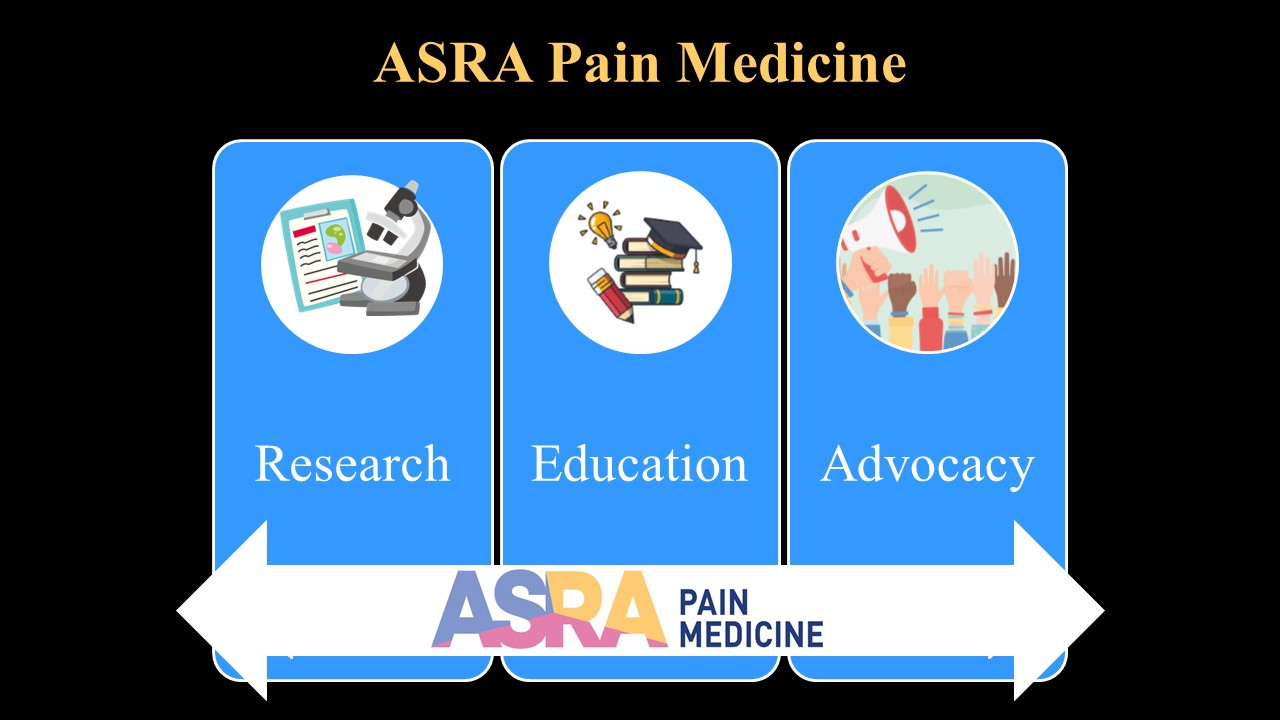
Figure 2
References
- Hyman SA, Card EB, De Leon-Casasola O, et al. Prevalence of burnout and its relationship to health status and social support in more than 1000 subspecialty anesthesiologists. Reg Anesth Pain Med 2021;46(5):381-87. http://www.doi.org/10.1136/rapm-2020-101520
- Rothstein A. ‘If I betray these words’ review: first, do no harm. The Wall Street Journal. https://www.wsj.com/articles/if-i-betray-these-words-review-first-do-no-harm-5cc49d2e. Published April 3, 2023. Accessed June 19, 2023.
- Stanley MPH. Opinion: doctors are losing their calling. The Wall Street Journal. https://www.wsj.com/articles/doctors-are-losing-their-calling-union-mass-general-brigham-resident-suicide-depression-representation-burnout-7f72ab6. Published March 23, 2023. Accessed June 19, 2023.
- O’Reilly KB. Cigna’s modifier 25 policy burdens doctors and deters prompt care. American Medical Association. https://www.ama-assn.org/practice-management/cpt/cigna-s-modifier-25-policy-burdens-doctors-and-deters-prompt-care. Published April 25, 2023. Accessed June 19, 2023.
- Kacik A. Hospital-employed physicians drain Medicare. Modern Healthcare. https://www.modernhealthcare.com/article/20171114/NEWS/171119942/hospital-employed-physicians-drain-medicare. Published November 15, 2017. Accessed June 19, 2023.
- Scott KW, Orav EJ, Cutler DM, et al. Changes in hospital-physician affiliations in U.S. hospitals and their effect on quality of care. Ann Intern Med 2017;166(1):1-8. http://www.doi.org/10.7326/M16-0125
- Neprash HT, Chernew ME, Hicks AL, et al. Association of financial integration between physicians and hospitals with commercial health care prices. JAMA Intern Med 2015;175(12):1932-39. http://www.doi.org/10.1001/jamainternmed.2015.4610